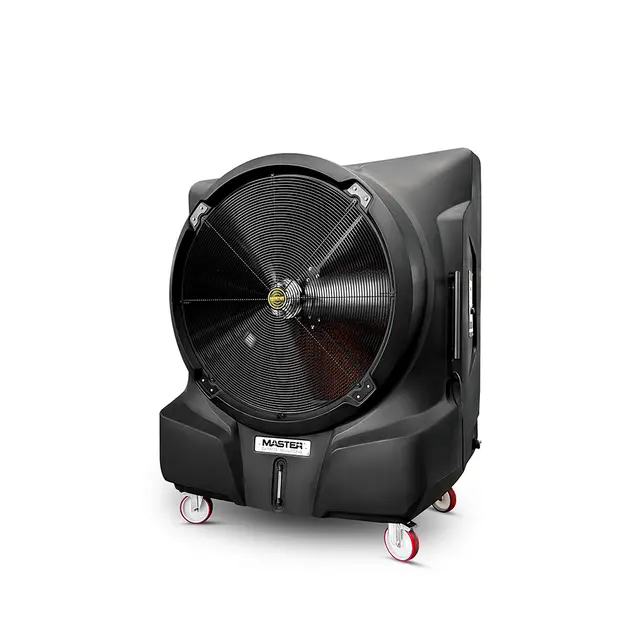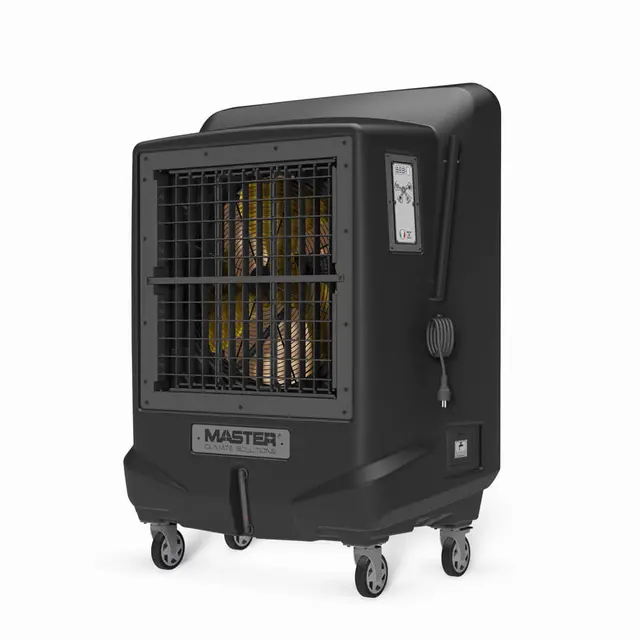What is evaporative cooling and is it better than traditional air-conditioning?
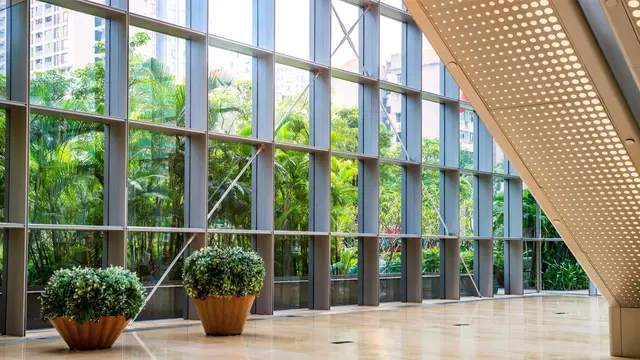
- Home
- Insights
- Cooling insights
- What is evaporative cooling and is it better than traditional air-conditioning?
Evaporative cooling, which uses the natural power of evaporation, is a clean, efficient, and environmentally responsible way to keep buildings cool. Here, we explain how it works and why more businesses prefer it over traditional air-conditioning systems.
Imagine exiting a swimming pool on a hot day. When the wind hits your body, you will feel a chill until you dry.
Water evaporation causes this cooling effect. For millennia, people have used the natural cooling process of evaporation to reduce temperatures in any environment, and modern evaporative air coolers (a.k.a. swamp coolers) achieve this efficiently and effectively.
However, many people are not aware of what evaporative coolers are or the benefits they offer over conventional air-conditioners. We will show you how evaporative cooling surpasses air-conditioning and provide examples of where these cooling solutions are used worldwide.
How does evaporative cooling work?
Evaporative cooling works by using water to absorb heat from a surface or the air. When water evaporates, it changes from liquid to gas, which requires energy. The energy comes from the surrounding air or surface, reducing its temperature.
In Ancient Egypt, Greece and Rome, they would hang wet mats in front of windows and tent openings to provide a cooling effect. Hundreds of years later, Leonardo Da Vinci experimented with the concept of a fan-driven evaporative cooler.
Modern evaporative coolers work using cooling pad technology. A powerful, silent fan draws hot air into the evaporative cooler. The air passes over water-soaked cooling pads, which absorb the heat and distribute much cooler air into the atmosphere.
A small water pump continually spreads water on the cooling pads, ensuring maximum cooling capacity.

In summary, today’s evaporative coolers use the natural power of evaporation to supply fresh, cool air in any environment.
7 standout benefits of evaporative cooling units
Now that you know how evaporative cooling works, you may be wondering what separates it from standard air-conditioning systems. Here are 7 significant benefits that industrial evaporative coolers deliver:
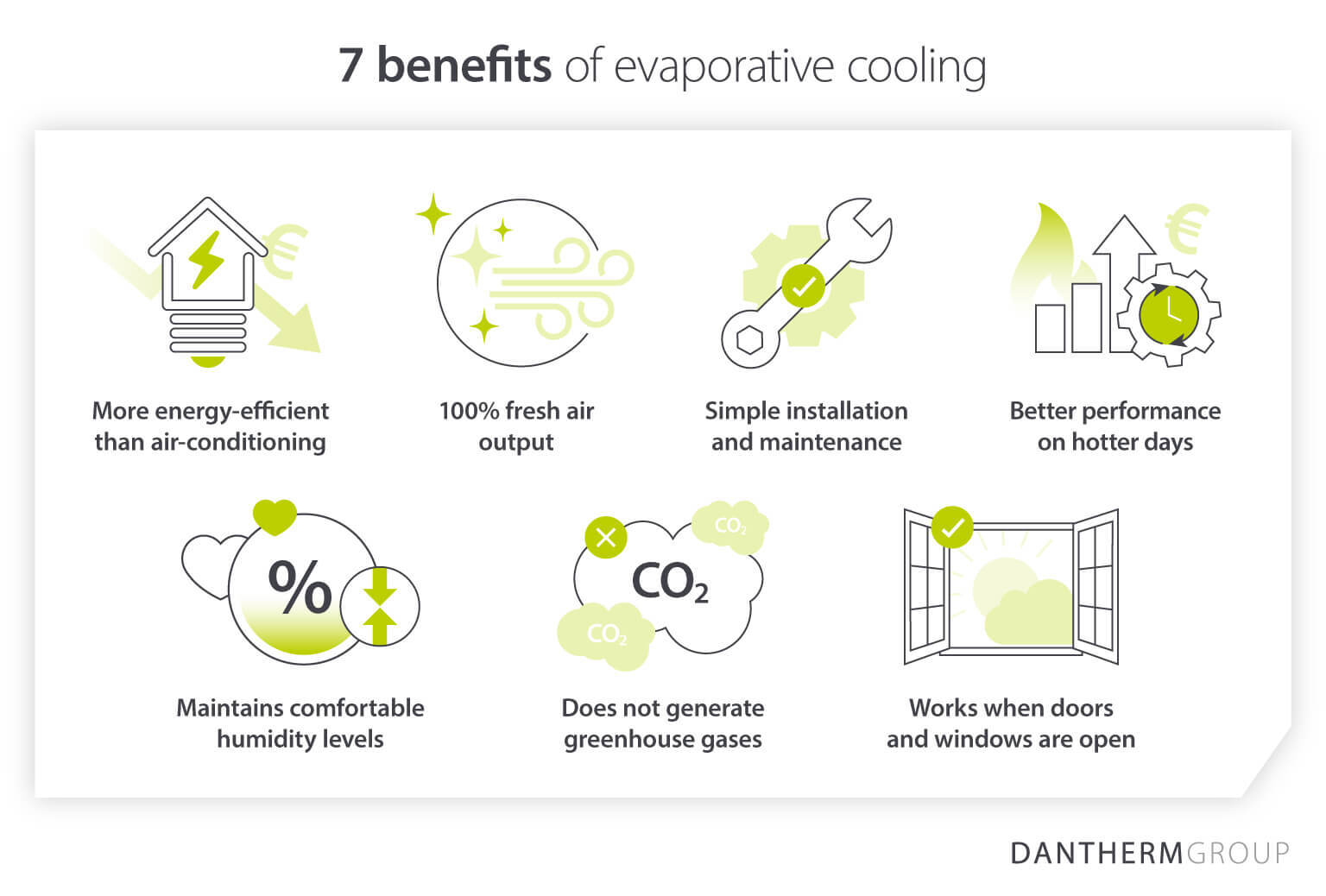
1. Uses up to 90% less energy than air-conditioners
First, modern evaporative coolers are extremely energy-efficient. Since evaporative cooling units only require energy for a fan and a small pump, they consume between 80% and 90% less energy than air-conditioning systems.
It costs the same energy for a split-type air-conditioner to cool a 12m² office as it would for an evaporative cooler to cool a 150m² warehouse. Overall, evaporative coolers are among the most energy-efficient cooling systems available.
2. 100% fresh air output minimises pollutants and odours
Rather than recirculate stale air, evaporative coolers supply fresh, clean air into a building. The fresh air circulation improves air quality, reducing unpleasant odours, smoke, gases and airborne contaminants.
3. Effective even when doors and windows are open
Unlike conventional air-conditioners, evaporative cooling is just as effective when doors and windows are open. Consequently, evaporative coolers are highly effective in warehouses and factories where doors and windows must frequently stay open.
4. Better cooling performance on hotter days
The cooling capacity of evaporative coolers increases based on the outdoor air temperature and humidity levels. In hot weather, an evaporative cooler can reduce temperatures by over 20ºC, depending on the relative humidity (RH). Put simply, the cooling effect is best when you need it most.
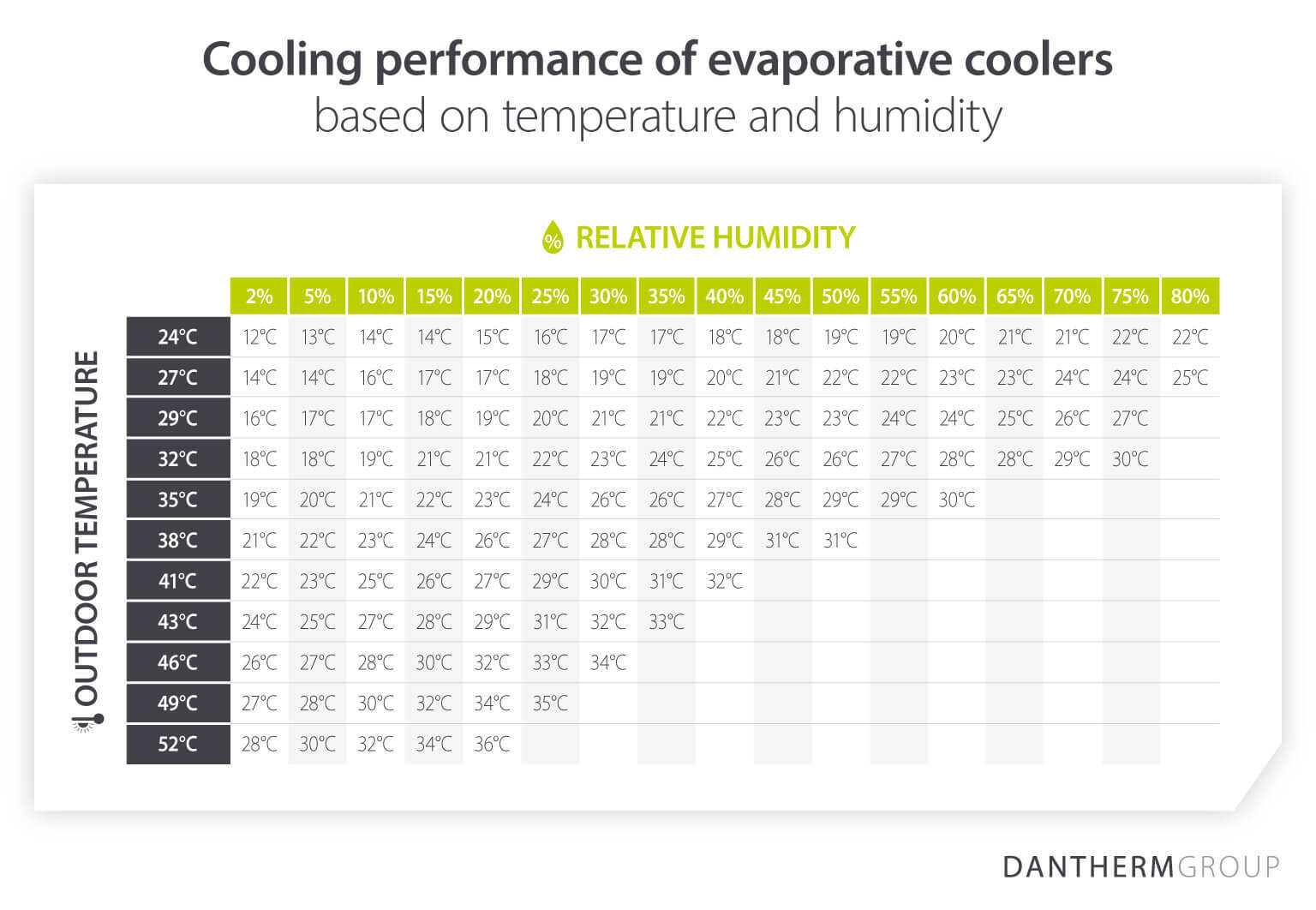
For example, in outdoor temperatures of 35ºC at 30% RH, an evaporative cooler can reduce indoor temperatures to 26ºC. At 41ºC at the same humidity level, the evaporative cooler can reduce temperatures to 30ºC – 2ºC more than the previous example.
In more humid climates, the performance of evaporative coolers will typically reduce. At Dantherm Group, we specially engineer our evaporative cooling units to perform well in high-humidity environments.
5. Maintains comfortable humidity levels
Speaking of humidity, evaporative coolers also help manage humidity control in your buildings. While traditional air-conditioners make the air considerably drier, evaporative coolers increase humidity by 2% to 5%, maintaining comfortable conditions.
6. Uses no chemicals or refrigerants
Conventional air-conditioning systems use chemicals and refrigerants to cool the air, which release greenhouse gas emissions.
In comparison, the only byproduct of evaporative coolers is water vapour. It is much kinder to the environment, enabling businesses to significantly reduce their carbon footprint and deliver more sustainable cooling.
7. Simple installation and maintenance
Finally, an evaporative cooler contains fewer components than a typical air-conditioner. This makes evaporative coolers much more cost-effective to install, and they are virtually maintenance-free.
Evaporative coolers vs air-conditioning systems
As highlighted above, evaporative coolers offer a wide range of benefits over standard air-conditioning systems. They help reduce your energy bills, minimise your carbon footprint and improve both air quality and humidity as well as air temperatures.
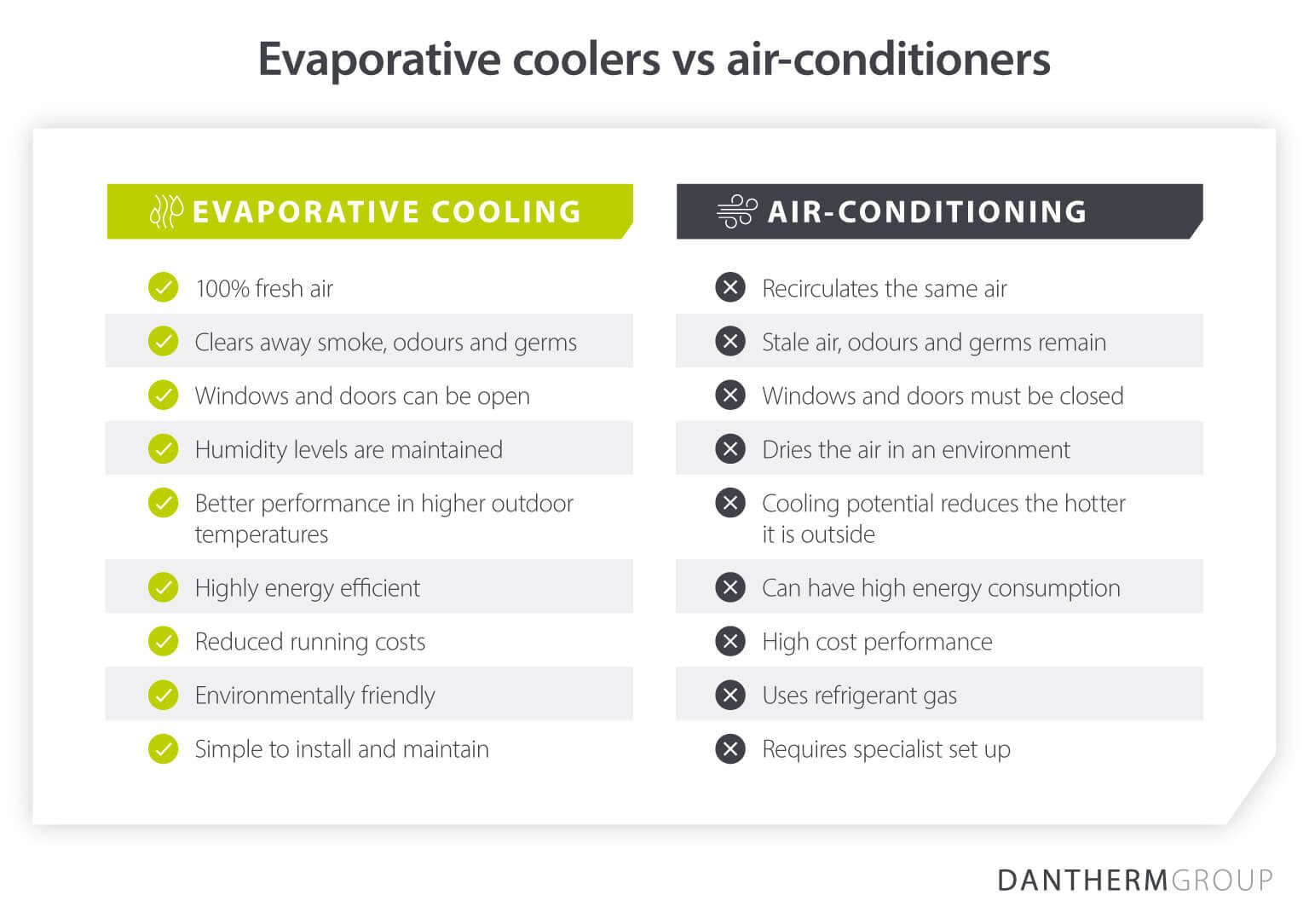
Where can evaporative cooling systems be used?
All industries can use industrial evaporative cooling solutions, but they are particularly effective for cooling large surface areas in an energy-efficient, practical manner.
Here are just 3 examples of industries benefiting from the power of evaporative cooling:
Warehouses and storage facilities
The large capacity of warehouse and storage facilities makes evaporative cooling more cost-effective than air-conditioning units.
As an example, we supplied 3 fixed evaporative cooling units with indoor diffusers for a 500m² warehouse in Paris. The solution enhanced workplace cooling in the hot summer months, improved employee satisfaction and minimised operational strain.
Outdoor events
Portable evaporative coolers can deliver much-needed air cooling at crowded outdoor events in extreme temperatures.
For instance, at an outdoor charity event in Singapore held in temperatures over 36ºC, we supplied 8 portable evaporative coolers to cool the air inside the tents. It was a practical, versatile, energy-saving and environmentally friendly solution.
Food and beverage production
Manufacturers must produce many foods and beverages at precise temperatures to achieve the best results.
One example is potato chips. At a food processing plant in Barcelona, we supplied an evaporative cooling solution that kept temperatures between 26°C and 27°C across the 500m² space. This preserved the quality of their potato snacks, supported heat stress prevention, and was more cost-effective than an equivalent air-conditioner.

Answering your evaporative cooling FAQs
Can I use evaporative coolers in places where I don’t want the humidity to increase?
Evaporative coolers naturally increase the relative humidity in an environment by 2% to 5%. To address this, consider the following:
Increasing ventilation with open doors and windows
Monitoring temperature and humidity levels using your evaporative coolers’ integrated control panel
Alternatively, spot cooling with portable evaporative coolers typically reduces the humidity production of evaporative cooling.
Does evaporative cooling increase the risk of Legionella because it uses water?
No. Our evaporative air coolers constantly move the water within them at a low temperature to prevent legionella growth. Many of our units also have integrated UV lights to further eliminate the threat of Legionella.
Can you reduce the noise level of evaporative coolers?
Yes. Our evaporative coolers come with speed adjustment capabilities so you can reduce fan speed if required. The typical sound level from our evaporative cooling units is between 60 and 66 dB.
Can I adapt the air flow of my evaporative cooler to my requirements?
Most of our evaporative coolers have louvers that allow you to control the air pattern and direction.
Alternatively, you could lift the air cooler to a higher place to direct the air away from people.
Choosing the right evaporative cooler for your needs
Evaporative air coolers are highly efficient, economical and effective at reducing air temperatures. However, it is crucial to select the right evaporative cooling unit to achieve the desired cooling and maximise energy savings:
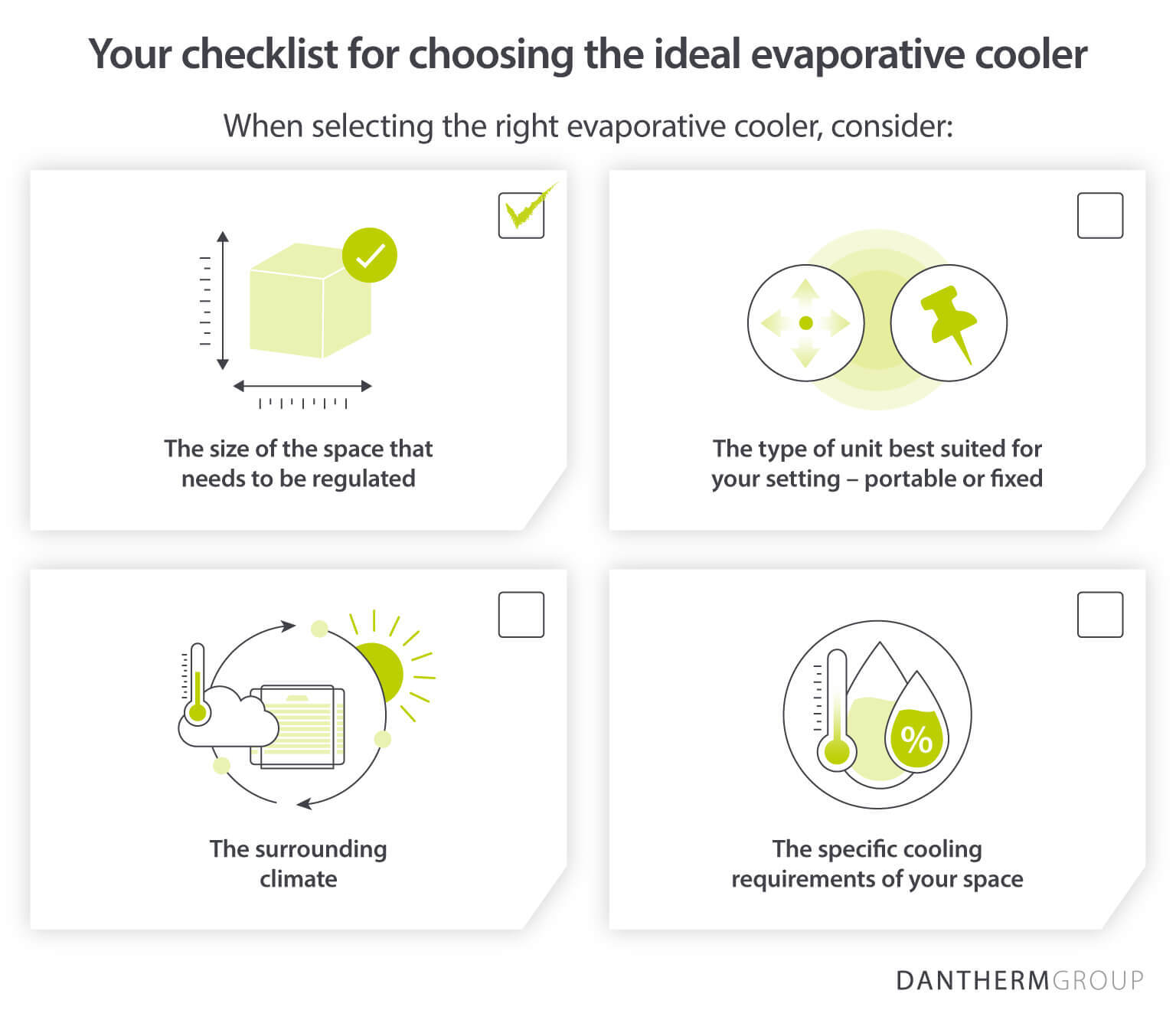
Dantherm Group is the European leader in evaporative cooling technology. We have the knowledge and experience to help you identify the most suitable solution across our wide range of robust, powerful air cooling units.
Our open-water distribution system ensures maximum cooling efficiency
Our units allow cooling of selected zones within a building
Automatic duct opening stops cold air from entering during winter and prevents hot air from escaping
Our Smart City Cooler control lets you remotely control and monitor up to 10 units at a time
Discover our complete range of evaporative coolers. For more information, get in touch with our team for an expert consultation.
Related products
Featured insights

Discover if evaporative cooling is the right choice for your environment

See the capabilities and benefits of evaporative cooling over alternative methods.

Learn the main differences and why evaporation is often a better choice
Need help with choosing the right solution? Our team of over 100 climate control experts can assist.
You can also reach out or join the discussion on our Social Media. Check out our LinkedIn page.
